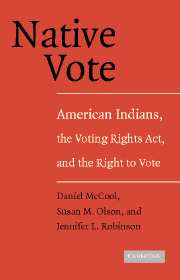1 - From Vanishing American to Voter
The Enfranchisement of American Indians
Published online by Cambridge University Press: 05 June 2012
Summary
The struggle for Indian suffrage has been a long one; it took nearly 200 years of effort to award U. S. citizenship to Indians and make them eligible to vote in national, state, and local elections. Thus the focus in this chapter is on overcoming the denial of Indian suffrage; most of the remainder of the book is about the abridgment of the Indian vote. The first section of this chapter describes the incremental bestowal of citizenship on American Indians. The second section focuses on state election laws and how they prohibited or impeded the Indian franchise. The conclusion interprets these developments in light of the passage of the Voting Rights Act (VRA).
Subjects Become Citizens
The authors of the Constitution did not envision Indian people as a part of the electorate. Congressional districts were apportioned among the states based on population, but “Indians not taxed” were excluded from the enumeration (Art. I. Sec. 2). This was in apparent recognition that most Indians were not under the jurisdiction of the fledgling U.S. government, and therefore taxes could not be levied against them. Indians are mentioned again in Article I, Section 8, where Congress is given the power to “regulate commerce with foreign nations, and among the several states, and with the Indian tribes.” The phrase clearly indicates that the Constitution's authors considered Indian tribes to be extrajurisdictional, lying somewhere between foreign nations and American citizens.
- Type
- Chapter
- Information
- Native VoteAmerican Indians, the Voting Rights Act, and the Right to Vote, pp. 1 - 20Publisher: Cambridge University PressPrint publication year: 2007

